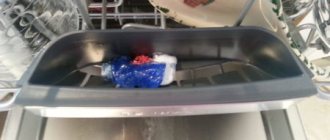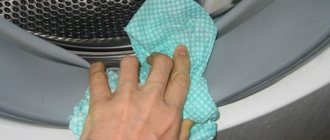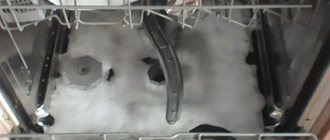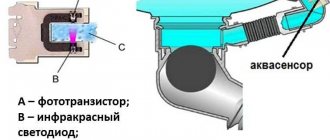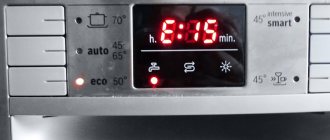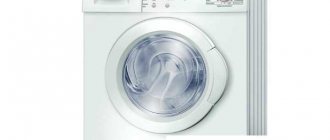If the dishwasher begins to wash dishes poorly, this means that it requires appropriate maintenance. Another option is possible: the user violates the rules for operating the device and therefore gets a bad result.
- Dishes are poorly washed in the PMM
- There is a residue left on the dishes
- Causes of malfunction and what to do
- Poorly washes dishes on the top shelf
- When you need a master
- Catalog of dishwashers with reviews
Dishes are poorly washed in the PMM
The dishwasher may not cope with its tasks for a number of reasons, including:
- incorrect placement of dishes in the chamber;
- device overload;
- incorrect choice of washing program;
- errors in the selection of household chemicals;
- lack of car maintenance;
- technical issues.
To find out why the equipment washes poorly, it is necessary to diagnose it. For this purpose, most models provide a special program. The error code displayed on the panel can be deciphered using the user manual. There you will also find troubleshooting solutions.
Expert opinion
I work in the household appliance repair industry. Extensive experience in restoring washing machines and dishwashers.
Ask a Question
Some problems can be solved on your own. To repair serious damage, you will have to contact specialists.
Dishwasher does not wash dishes well: reasons
The reasons causing the poor quality of work of a kitchen assistant include both the human factor and ordinary malfunctions. At the same time, the PMM does not always report problems, that is, error codes may not be displayed on device displays.
Household appliances from Bosch, Siemens, Electrolux and other well-known brands will not wash kitchen utensils well due to the following problems:
- caring for the dishwasher does not comply with the manufacturer's instructions;
- in the process of using PMM, users make mistakes;
- detergents that are not intended for dishwashers are used, or their dosage is not observed;
- Some of the parts of the device do not work or work poorly, for example, the layer of scale becomes too large and does not allow the electric heater (hereinafter also referred to as the heating element) to heat the water to the desired temperature.
Scale on the heating element can cause overheating of the part and its complete failure
There is a residue left on the dishes
Sometimes, over time, a certain residue appears on the dishes. To get rid of it and prevent new troubles from arising, you need to:
- monitor the amount of regenerating composition;
- select the appropriate washing mode and adjust the salt supply in accordance with the water hardness;
- clean the internal parts of the machine from scale;
- Use detergents recommended by the equipment manufacturer and follow their dosage.
When filling the salt container, be careful. The lid of the tank must be closed tightly, otherwise the substance will enter the washing chamber, and this in turn will lead to the appearance of deposits on the dishes.
dish basket
Problems associated with incorrect use of the dishwasher
- Leftover food and dried food. If you do not remove all this from the dishes, then the quality of washing will never be ideal. All manufacturers warn about this rule, and it is recommended to follow it.
- Incorrect mode selection. Economy and short programs are intended only for light soiling, while greasy dishes require the longest cycle at the highest temperature.
- Machine overload. If your dishwasher isn't cleaning dishes well, you may be loading too many dishes and other utensils into the dishwasher. Try putting in fewer dishes next time - most likely your problem will be solved.
- Incorrect use of detergents. The wrong choice of cleaning chemicals and/or their quantity is a common reason for poor dishwasher performance. Try decreasing or increasing the amount of rinse aid, or even changing its brand.
If all these manipulations did not lead to a positive result, and your dishwasher still does not wash dishes well, then you will have to get to know it better. Or rather, with its internal structure. Some problems arise as a result of regular use of the dishwasher and can easily be solved without the involvement of specialists.
Causes of malfunction and what to do
Incorrect operation
Dishwasher owners usually make the following mistakes when using their appliances:
- Kitchenware is not prepared for loading. To obtain a satisfactory washing result, plates must be cleared of food debris and napkins. Failure to follow this rule will lead not only to unwashed dishes, but also to clogged filters.
- The washing program is selected incorrectly. When loading a large volume of heavily soiled dishes, select a long high-temperature mode.
- Kitchen utensils are placed in the washing chamber haphazardly and too tightly. There must be a certain distance between the dishes; the hopper must not be overloaded.
- Unsuitable household chemicals are used. Try replacing your powder or tablets with a new product or adjusting your dose.
Expert opinion
I work in the household appliance repair industry. Extensive experience in restoring washing machines and dishwashers.
Ask a Question
The operating rules for the device are described in detail in the attached instructions.
Blockage
Filters and small holes in various parts of the machine become clogged due to the user not properly cleaning the plates before loading them into the hopper. To eliminate this problem, you need to remove the parts and wash them under running water. You can remove small debris from the holes using toothpicks.
Manufacturers of PMM recommend regularly washing filters so that the quality of washing does not deteriorate and the equipment does not break down.
Clogged dishwasher
Late cleaning of parts
The external surfaces and internal parts of the machine must be kept clean. In addition to filters and sprayers, thoroughly clean the chamber walls. To do this, first remove the baskets from it and soak them in a container with hot water and detergent. After this procedure, traces of grease and other contaminants will be washed off more easily. Then wipe the clean baskets dry and put them back in place.
The tubular electric heater also needs to be cleaned to remove scale and dirt. But this is only possible in older models, when it was located in the chamber.
Small particles of debris accumulate in the rubber door seal. You can clean it with a toothbrush and detergent.
Manufacturers recommend wiping all accessible surfaces of the dishwasher with a dry cloth after each operating cycle. Do not forget to ventilate the bunker and periodically leave the door open.
Using cheap detergents
Companies that produce household kitchen appliances provide recommendations to users regarding cleaning products. The use of cheap products or their incorrect dosage impairs the performance of the device and has a negative impact on the washing result.
The appearance of scale on dishwasher parts
Even if you use regenerating salt in your PMM properly, hard water scale may form on metal parts. Limescale gradually closes the holes in the filters and sprayers and clogs the drain hose.
To eliminate this problem, experts recommend periodically running a dry wash at high temperature, adding citric acid rather than detergent. Inexpensive but effective substance copes well with deposits.
Limescale
Incorrectly set operating mode
Premium smart dishwashers are equipped with a function that automatically detects the desired program. The equipment independently selects the water temperature, cycle duration and washing intensity.
If your machine does not have these technical capabilities, choose the mode correctly so as not to overload the device and waste unnecessary resources. Consider the volume of dirty dishes and the degree of soiling.
Expert opinion
I work in the household appliance repair industry. Extensive experience in restoring washing machines and dishwashers.
Ask a Question
Remember that the short economy mode is more suitable for refreshing dishes. A mountain of accumulated plates with dried food remains will not be washed under such conditions.
Untimely cleaning of PMM parts
A dishwasher, like any household appliance, requires careful care and timely cleaning of individual parts and components. The following elements in the unit are subject to regular cleaning:
- The tank must be cleaned of plaque.
- Coarse filter, which is installed on the inlet hose. It can become clogged with rust or small particles of scale that form when welding pipes during pipeline repair.
- The water sprinklers (rocker arms) can be carefully removed for cleaning. They become clogged with food debris or limescale. Due to the insufficient diameter of the holes in the nozzles, the pressure of the sprayed water is reduced, and therefore the dishwasher does not rinse the contents effectively. The upper rocker arm is unscrewed, and the lower one is removed by sliding upwards. Clean the injectors with a regular toothpick under a good stream of water. Also, cleaning can be done without removing the spray arms by running the device in idle mode with the addition of a special descaling agent, which will dissolve grease in the nozzles and limescale deposits. This descaling procedure will also be useful for the heating element.
- The main filter, which is installed at the bottom of the tank. It is a fine mesh that can be easily removed. You need to wash it regularly, and at least once a week.
Rinsing the PMM using a special product should be carried out once every six months. And this does not depend on the frequency of use of the unit.
After each completion of the utensil washing program, the appliance should be checked for any food residues that may be in the machine's tank or under the door, especially if it is a Bosch dishwasher.
Poorly washes dishes on the top shelf
Users note that dishes located on the top shelf of the chamber are washed worse than the rest of the volume. This may occur due to the fact that objects on the middle and lower shelves block water from accessing the top one. And also in such a situation, it is worth checking the upper rocker for blockages.
Arrange kitchen appliances, keeping a small space between them, in accordance with the diagram given in the instructions. Do not exceed the recommended load and ensure that all items drain well. Do not place dishes that are not machine washable in the chamber.
Consequences of improper use
One common mistake is loading cutlery items incorrectly into the sink baskets. A careless attitude to the rules for arranging dishes can play a cruel joke on the owner.
If you place the cups haphazardly, bottom down, the dishwasher will not wash them well
The instructions included with each PMM model describe the rules for laying out cutlery, which must be strictly followed - only in this case the manufacturer guarantees the high-quality operation of the dishwasher.
There are several rules that are required to fill out all PMMs:
- plates, cups and pots must be positioned in such a way that liquid can drain from them;
- There should be gaps between tableware so that water can freely pass through them in both directions;
- cutlery located in the lower basket should not prevent liquid from flowing from the lower sprayer onto the dishes in the upper basket;
- Tableware should be placed in such a way that it does not interfere with the rotation of the spray arms.
Do not overload the dishwasher as this will make it difficult for detergent to reach the surfaces of cutlery. As a result, the dishes will not be washed well .
We invite readers to watch a video showing how to properly place utensils in the dishwasher:
We invite you to read our article on how to properly load dishes into the dishwasher.
The wrong choice of the PMM operating program is another user mistake. This is mainly due to the discrepancy between the temperature of the liquid and the value that is necessary to remove dried food debris. The dishwasher will stop washing dishes well, removing dried dirt from the surface of the plates, if you run the quick wash mode. In this mode, the water temperature does not exceed +50 ℃, and this is not enough for high-quality cleaning of cutlery.
If immediately after eating you free the dishes from food residues so that they do not dry out on the surface, then the cutlery can be washed quickly and the filter will become clogged much less.
When you need a master
Control module operation error
The control module controls the functioning of the device. If there are errors in the module, malfunctions occur in the operation of the machine: incorrect actions are performed or the equipment is turned off.
Only a professional can determine how to correct the situation. In the most favorable scenario, the control module is reflashed, that is, its software is updated.
PMM module
Broken recirculation pump
The recirculation pump pumps water into the system and supplies it to the washing chamber. If the unit malfunctions, the water pressure drops and the machine stops working completely. It is not worth repairing or changing the part yourself; it is better to contact a specialist.
circulation pump
The heating element has burned out
The dishwasher is equipped with a water heater, on the surface of which scale often accumulates. A heating element coated with a layer of limescale can quickly burn out. The machine will have to wash the dishes with cold water, since there will be no heating. This unit cannot be repaired; it must be replaced.
Damage to the water turbidity sensor
The turbidity sensor, found in advanced dishwashers from well-known brands, serves to check the quality of the water. When a certain level of turbidity is reached, a corresponding signal is sent to the controller, and the machine continues to wash the dishes.
If the result of the PMM operation is not satisfactory to the user, the cause may be a faulty sensor that transmits incorrect information to the software module about the contamination of the dishes. The technician will replace this part with a working one, and the machine will return to working condition.
Sprinkler impeller failure
If the impeller that rotates the rocker arm with sprayers breaks, the dishes are not washed properly, since the water in the chamber is not distributed correctly. To replace this part, you will have to contact a service workshop.
hsie 2b19
Thermal relay burnt out
The thermal relay is a water temperature sensor that supplies information to the electronic module. If the device stops transmitting correct data, the heating element does not turn on. Dishes do not wash well in cold water, and the user notices this. In this case, you need to install a new temperature sensor.
These are all the reasons why a dishwasher does not wash dishes well. To keep your dishwasher in good working condition for as long as possible, follow simple operating rules.
Correcting serious technical violations in the operation of equipment requires certain knowledge and skills. Therefore, if it is impossible to fix the breakdown on your own, contact a specialized workshop for repairing dishwashers of certain brands.


